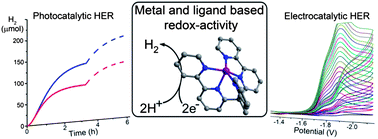Catalytic protonreduction with transition metal complexes of the redox-active ligandbpy2PYMe†
Abstract
A new pentadentate, redox-active

* Corresponding authors
a Department of Chemistry, University of California, Berkeley, California 94720, USA
b Materials Sciences Division and Chemical Sciences Division, Lawrence Berkeley National Laboratory, Berkeley, California 94720, USA
c Department of Chemistry and Center for Photochemical Sciences, Bowling Green State University, Bowling Green, Ohio 43403, USA
d Chemical Sciences Division, Lawrence Berkeley National Laboratory, Berkeley, California 94720, USA
e
Howard Hughes Medical Institute, University of California, Berkeley, California 94720, USA
E-mail:
chrischang@berkeley.edu, jrlong@berkeley.edu, castell@bgsu.edu
f Department of Molecular and Cell Biology, University of California, Berkeley, California 94720, USA
A new pentadentate, redox-active

 Please wait while we load your content...
Something went wrong. Try again?
Please wait while we load your content...
Something went wrong. Try again?
M. Nippe, R. S. Khnayzer, J. A. Panetier, D. Z. Zee, B. S. Olaiya, M. Head-Gordon, C. J. Chang, F. N. Castellano and J. R. Long, Chem. Sci., 2013, 4, 3934 DOI: 10.1039/C3SC51660A
To request permission to reproduce material from this article, please go to the Copyright Clearance Center request page.
If you are an author contributing to an RSC publication, you do not need to request permission provided correct acknowledgement is given.
If you are the author of this article, you do not need to request permission to reproduce figures and diagrams provided correct acknowledgement is given. If you want to reproduce the whole article in a third-party publication (excluding your thesis/dissertation for which permission is not required) please go to the Copyright Clearance Center request page.
Read more about how to correctly acknowledge RSC content.
 Fetching data from CrossRef.
Fetching data from CrossRef.
This may take some time to load.
Loading related content
